PR Measurement: The Ultimate Guide
PR measurement was more of an afterthought than a strategy not so long ago. Thankfully for PR practitioners and the people they answer to, whether clients or leadership, measurement has since become a mainstream conversation.
The industry as a whole is starting to move away from “traditional” metrics like Advertising Value Equivalencies (AVEs) and is adopting new metrics that more closely align with a business environment that wants data-driven insights.
AVEs date back to when a PR practitioner could measure the size and space of a physical piece of coverage and then deduce what the same space would have cost had it been an ad.
AVEs put neat boundaries around measuring PR but they fail to consider the quality of the coverage (think prominence, outlet, tone, sentiment, appearance by spokesperson, adherence to key messages), and are not applicable to other activities beyond earned media. As further proof, the 2020 update of the Barcelona Principles—a set of voluntary guidelines for measuring PR first developed in 2010—say very clearly that AVEs are not the value of communication.
Unfortunately, AVEs are super easy to understand and explain to your clients and C-suite.
People get money.
Along with AVEs, another PR measurement concept that’s had its day is the idea that measurement programs happen after you’re done your PR activities.
If you’re not devising a measurement program before the launch of your campaign, how do you know what’s important? How will you know if you’ve been successful? How will you prove value? How will you show that your PR efforts have made any sort of meaningful impact on business goals?
That’s a lot of questions to let go unanswered.
Over the last decade, PR measurement has gone through a turbulent but transformative change. Professionals in the space—including leading industry organizations—have aggressively discussed and debated that if AVEs are no longer valuable, what is? This has led to PR professionals embracing new strategies and discarding traditional metrics like AVEs and other such vanity metrics.
PR has a lot to offer. And it’s time everyone knew it. So, here’s what we’ll look at:
- Part 1: Impact
- Part II: Common PR measurement mistakes
- Part III: Pulling it all together
- Moving forward
Part 1: Impact
Alright. We’ve adequately set the stage for why a PR measurement framework that allows you to connect your PR impact to business goals is essential. Before we go any further into impact, there are three very important points we want to make.
Point 1: There is no single magic metric that will replace AVEs.
Especially not one that will provide a universal value for all your various activities. When building your measurement framework, look at each of your PR activities individually and determine which metric(s) best capture success. It will take more work, but the efforts will be worth it.
Point 2: If you still use AVEs, we’re not here to condemn you.
We will encourage you to look at them as you would other metrics—which is, not in isolation. Otherwise, the value is far too open to interpretation. If all your media coverage this month was worth $150,000 in advertising equivalencies, that’s great… right? Not if your goal was $250,000 and last month your coverage was worth $300,000. Metrics are far more valuable and useful when you have benchmarks or goals to compare them to.
Point 3: If you don’t have benchmarks—set them!
Look at your media coverage, your web traffic, social media followers, or whatever is important to you, for the last month, quarter, or year. If you don’t keep track already, you’ll need to devote a bit of time to the project, but we promise that you’ll thank us for it later.
Defining impact in PR measurement
Proving impact in a way that your clients or your company’s C-suite will understand, appreciate, and care about isn’t an easy task. But it can be done, and it’s simpler than you might think.
The dictionary says impact is to “have a strong effect on someone or something”. We’d like to modify that definition a bit and say that impact is having a desired effect on a desired outcome.
Impact doesn’t have to be a big deal, and thinking it does can be a mental barrier to success. So, let’s set that notion aside right now.
With direct impact, a PR activity has a clearly visible business outcome. Here are some real-world examples:
-
- A banking company re-launches their wealth management business. After an article about their new business is published in a leading paper, they receive multiple inquiries which reference the article.
- An agency gets their retail client’s product showcased in a popular afternoon talk show. Within the next couple of days, the highlighted product sells out.
In such cases the connection is undeniable. The efforts of the PR team led to identifiable and measurable actions by the audience, and even sales. The numbers speak for themselves.
If only it were always like that.
More likely you’ll end up with indirect impact—a PR activity that has an implied business outcome.
To measure indirect impact, we need proxy metrics—a metric that can be used to represent the value of something else. You can also think of them as “one-step-removed” metrics.
PR will rarely get the credit for increasing sales or winning new customers. Even if you got your hands on the data, you wouldn’t be able to draw a straight line from your PR outcomes to overall revenue. Proxy metrics will be your best friend for proving indirect impact. The three most useful ones are:
-
- Awareness
- Engagement
- Reputation
Whatever impact you make, remember, it’s all feel-good fluff unless you connect it back to business goals. Which means, before you begin anything, you need to know—in detail—what the business you serve hopes to achieve, whether it’s this month, this quarter, or this year. Once you know that, you can:
-
- Determine how PR can contribute to the business goal
- Make a plan for achieving the desired outcomes
- Decide which metrics you’re going to track to prove your impact (direct or indirect)
That’s a really simplified version of the process and it’s up to you to fill in the blanks.
Here it is broken down a bit more and placed into an accessible framework that our team uses with clients.
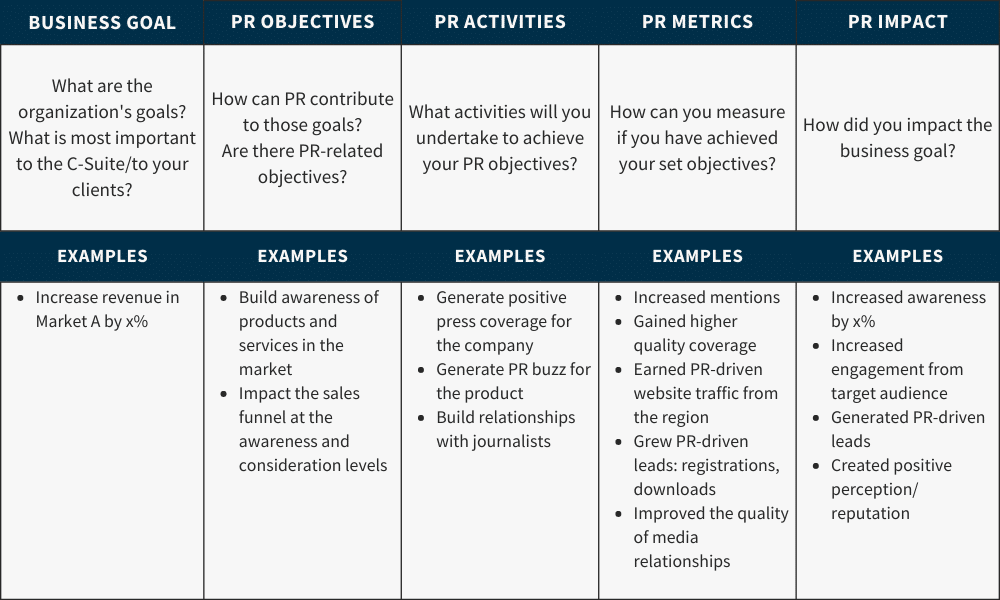
Changing the language
If you looked at that chart and thought to yourself, “I do 80% of this already,” congratulations! The final 20% comes when you change the way you present your results to the C-suite or to your clients.
When you describe results using vanity metrics, you may as well be speaking Latin to the people you need to impress. You’ll probably draw blank stares, maybe someone will say “so what”, or even worse… you’ll get laughed out of the room.
To avoid all three of those unpleasant situations, bypass terms like:
-
- Impressions
- Reach
- Sentiment
- Volume
- Followers
- Likes
- Shares
And instead use terms like:
-
- Awareness
- Engagement
- Reputation
- Share of voice
- Call to action response
- Community/relationships
Notice a few familiar friends at the top of the list?
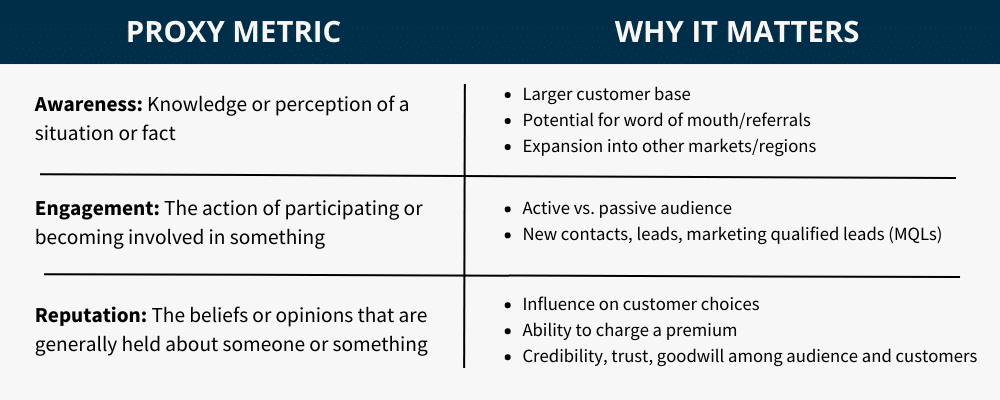
Translating your metrics into the language of impact may take some practice at first, but we know you’ll get the hang of it. Here are some examples:
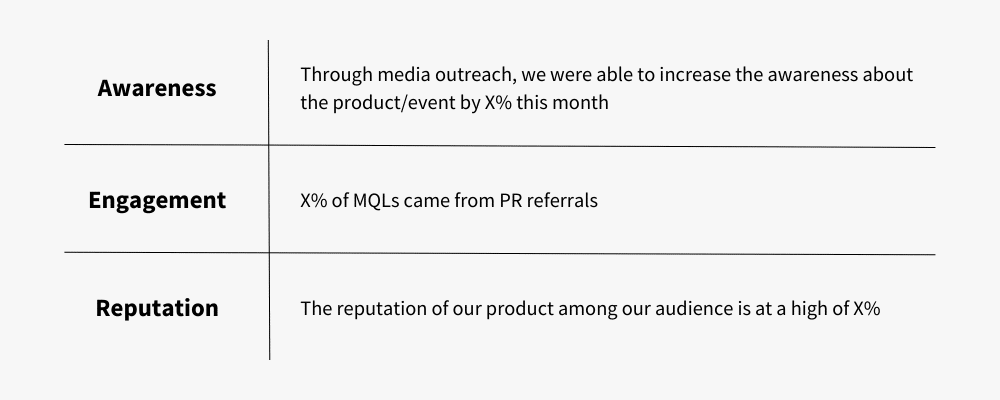
If you’re still struggling with either why this matters or how to do it, think of it like this…
What’s more appealing—being served a delicious, gourmet meal or receiving all the separate ingredients?
The metrics you’ve chosen to measure your activities are valid by themselves. They are the essential ingredients for creating a delicious meal. You may be able to see the sum of the parts, but your C-suite/client needs you to combine the ingredients into something they can enjoy.
Let’s see this in action:
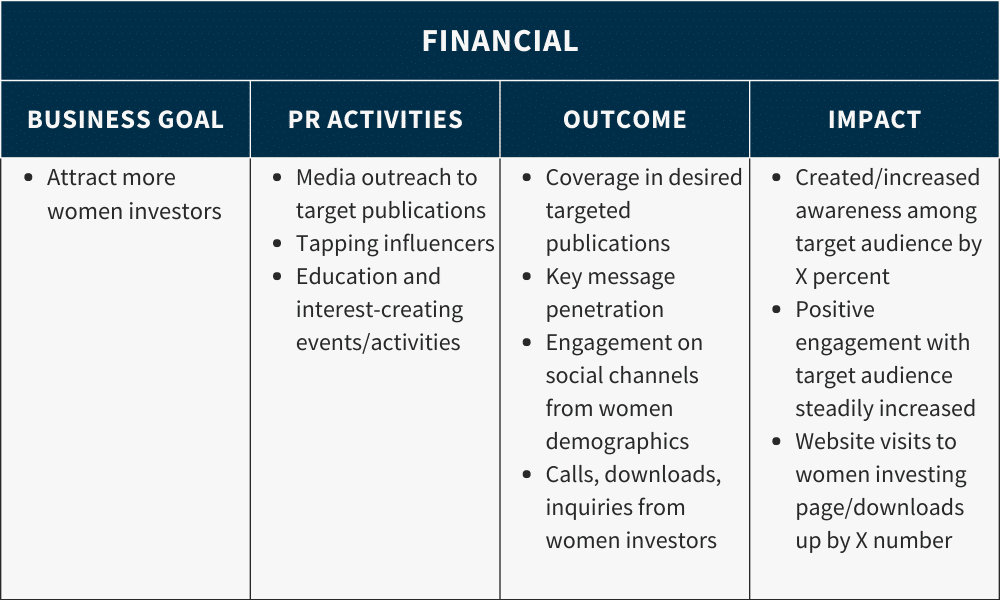
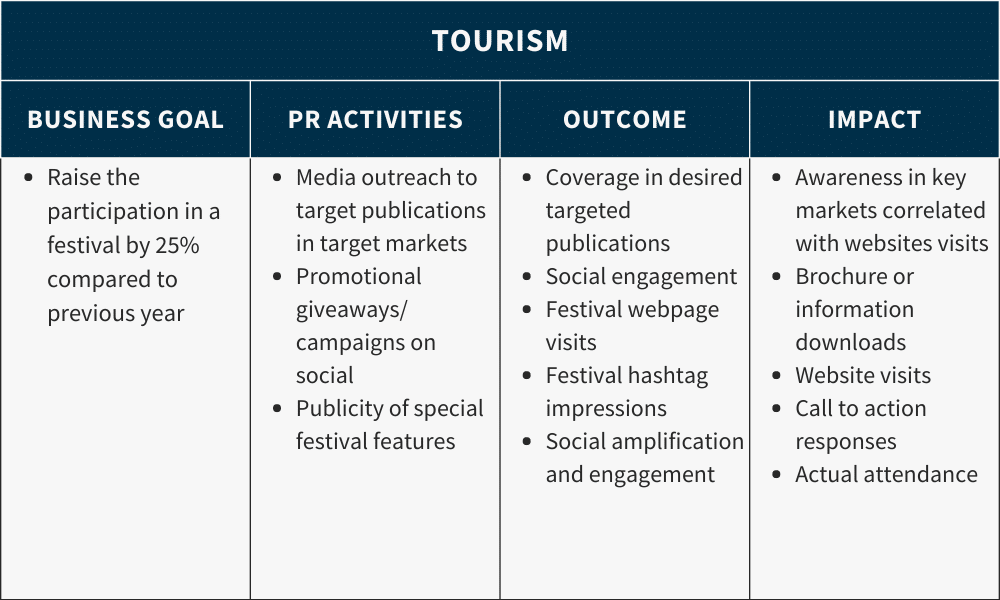
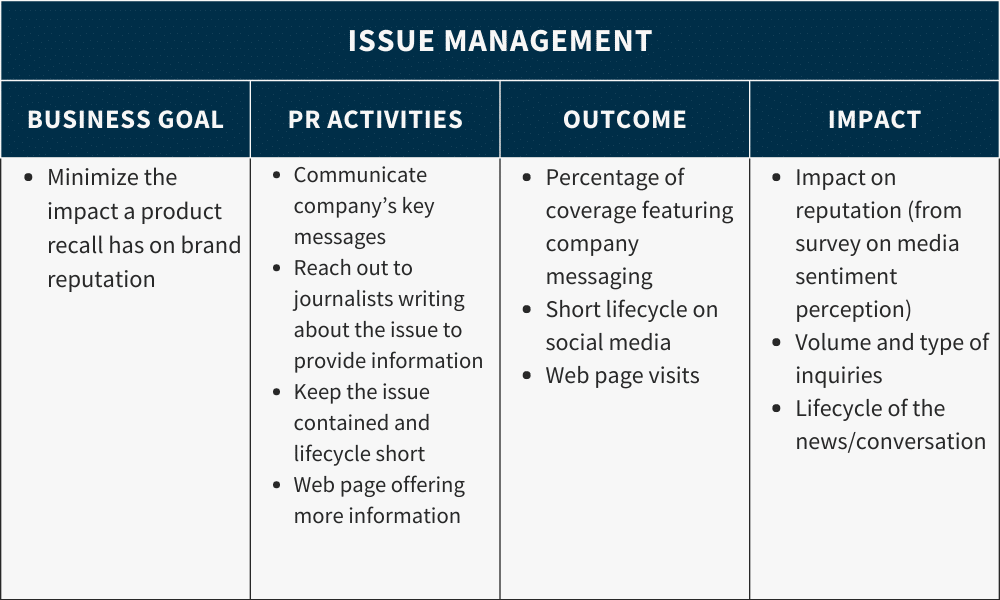
In these three examples, the “Impact” column puts all the ingredients together and serves a delicious meal using the now very familiar proxy metrics: awareness, engagement, and reputation.
PR and the customer journey
The sales funnel is a familiar image.
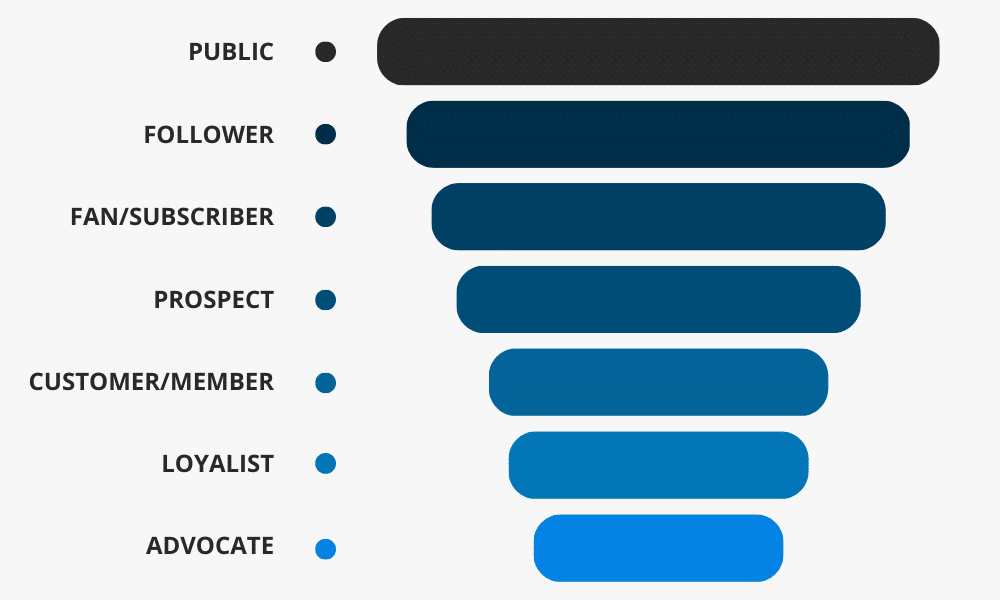
Marketing isn’t the only department responsible for keeping it full. PR plays a role too, specifically with awareness, reputation, and engagement.
At the top of the funnel is awareness. The fuller the top of the funnel, the more people are aware of your product, service, client, or brand, and the more likely you are to generate sales. A huge boon to awareness is earned media.
As you move down the funnel you come to engagement. The public turns into friends, fans, and followers. PR owns relationships and community building in a significant and impactful way. People who are part of a community or who feel like they have a personal relationship with something are more willing and more likely to engage. They comment, share, like, retweet, download, visit, and register.
Reputation isn’t attached to any specific stage of the customer journey or level of the funnel because it’s omnipresent. It matters all the time. Building that positive perception and image about the product, brand, or company helps keep the funnel healthy, full, and moving, and eventually leads to overall revenue.
Part II: Common PR Measurement Mistakes
Now that we’ve covered the importance of connecting PR outcomes to business goals using the language of impact, you’re probably eager to begin revolutionizing your PR measurement program.
Before you do…
There are five significant mistakes that could sabotage your success and make your well-meaning PR measurement program can go awry.
What are they? We’re so glad you asked!
-
- Jumping right in without calibrating your measurement efforts to business objectives
- Starting a measurement program without determining reporting resolution
- Using narrow metrics to evaluate performance without integrating across dimensions
- Missing the underlying trends and patterns by failing to segment data
- Presenting data in a way that takes too much effort to understand
We delve into these five mistakes in greater detail in our guide, Measuring Impact: How to Successfully Connect PR Activities and Outcomes to Business Goals. Or you can check out the free Agility webinar, 5 PR Measurement Mistakes that Sabotage Your Success.
Flipping these PR measurement mistakes on their head
Making any of these five mistakes will undermine your PR measurement program and likely your personal influence and impact too. But, if you flip these mistakes on their head and get them right, they can be the foundation for your success.
Jeremy Parkin, Manager, Data Analytics & Media Intelligence here at Agility calls getting it right the CRISP reporting framework, an acronym for calibration, resolution, integration, segmentation, and presentation.
Now, we don’t want to give away all our trade secrets, but we do share a couple of fixes that will set you on the right path in our guide, Measuring Impact.
The CRISP framework
Following the CRISP framework allows you to create a PR measurement program that really lets you know what’s working and what’s not. It lets you focus your efforts and resources on the areas with the most opportunity.
So, when you go into those meetings where everyone is going on and on about their instincts and opinions, you’ll be the person with the impossible-to-ignore data.
But as Uncle Ben told Peter Parker, “With great power, comes great responsibility.” Use your data to earn trust and credibility and gain influence so that you can win more resources for your team and program to make an even bigger splash.
Part III: Pulling it all together
As a PR or comms professional, you can’t be scared of data. You should want to go deep (like 20 pages deep) to really dissect each and every component of your measurement plan.
But something that intense isn’t going to work with your C-Suite or your client’s leadership (“Mistake 2: Starting a PR measurement program without determining reporting resolution”). Instead focus on key activities, outputs, and impact.
For an example of how you can pull it all together in a stunning visual display download Measuring Impact for free.
This example dashboard is a concise yet complete summary of everything you have done, the outcomes of your activities, and how your activities are impacting the business. Please note that this is an example of a high-altitude dashboard meant for leadership and is not the type of dashboard you would use with your own PR or comms team (that would be far more detailed and in-depth!)
Challenges to meaningful PR measurement
If after reading this guide you still feel lost, analyze your situation and see what barriers you’re facing. Common challenges can be lumped into three main categories: data, time, and budget.
Data
Data for the sake of data won’t be useful to you, and you’ll soon find it especially overwhelming if you don’t have any formal data gathering and analysis processes.
When you know what it is you’re looking to measure (awareness, reputation, and engagement), you can find the data that highlights the impact and helps tell your story. Otherwise, it’s all too easy to drown in numbers.
How to begin:
-
- Start with your PR data. Make sure the vendor or tool you are using is reliable and has high data integrity.
- Integrating data from other departments, like marketing and sales, is always challenging, so pluck the low hanging fruit. Website analytics is an easy one to access and use.
- Harness other established sources of data. You will be surprised at how much is already gathered and used. For example:
-
- Sales data on average deal time
- HR data on average hit rates for new job postings
- Customer service data collected from chat tools
- Regular customer/employee surveys
-
Look for the business impact you are gearing your activities towards, for example, sales, hiring, or customer satisfaction. Which department “owns” that impact? How do they track their data? Talking ahead of time allows for collaboration—perhaps they use some data gathering processes that could help facilitate your post-campaign measurement.
Resources
Tools: Make sure you have the right tools and make your vendors and/or agencies work harder for you. Do not compromise on your end goals. A good vendor will want to work with you to provide more. Ask specific questions.
You might find these two articles useful if you’re planning to use media monitoring or media database tools.
Time: For your PR measurement program to work, you have to commit to giving it the time, energy, and attention it needs to be successful. While you may have people, tools, and vendors, at the end of the day it’s your inputs and directional guidance that are critical in making it work.
Culture
Does your organization have a data-driven culture? If the answer is yes, that’s great news! It makes your job easier. But if it doesn’t, then this is a great opportunity for you to take the lead and prove how it can benefit the company as a whole.
Need an edge on convincing the skeptical? If you are fighting for something, be it budget, data, or tools, create mock-ups of what the end-product could look like (such as that snazzy dashboard from earlier). Being able to visualize the outcome really helps people understand and appreciate what they’ll get.
Budget: Asking for more money is always a challenge, but if you look and prioritize, there is so much that can be started within your existing scope. As you show the impact of your efforts, it builds a case for increasing your budget.
Check-in
Well done! You’ve implemented all these strategies and are now connecting your PR outcomes to business goals and have started speaking the business language.
Now, what does personal success look like?
When you can stop fighting so hard.
If your leadership or clients are impressed with all the coverage you bring in, but every year the same “why do we need you?” conversation happens, that’s not success.
Even if you do have a sense of security, we’re definitely not saying rest on your laurels. There’s always room for improvement, but success means that your contract or your budget isn’t always up for discussion. It means having the confidence of your C-suite or your clients.
Moving forward
If you leave with nothing else after reading this guide, we hope that you take away the following points:
-
- Identify a business goal that you can impact through PR
- Make a plan for how you will contribute to the company goal
- Determine the PR metrics by which you will measure direct or indirect impact
- Avoid the five common PR measurement mistakes
- Speak about impact when you present the results
If you could use some extra help making the most out of your data, we offer human-curated monitoring, and expert PR measurement and analysis services.
Enjoy a free consultation to find the right solution for you.
Download your free PR measurement guide today!
Sign up to receive your guide and occasional emails about PR news and resources.
We take your privacy seriously & will never sell your info. You are free to opt-out at any time. Privacy policy

